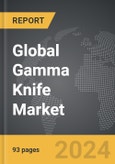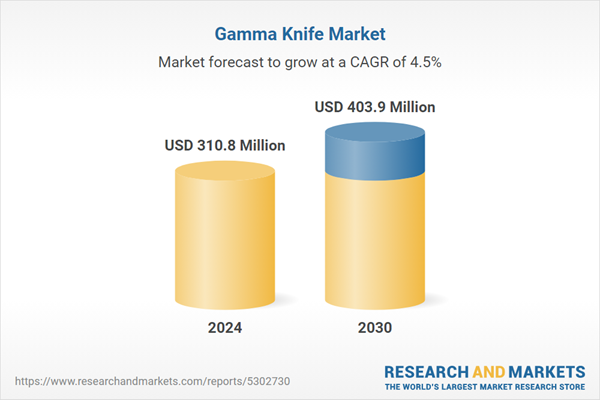Global Gamma Knife Market - Definition, Key Trends & Drivers Summarized
What Is Gamma Knife and Why Is It Important in Modern Neurosurgery?
Gamma Knife is a form of stereotactic radiosurgery (SRS) used to treat brain tumors, vascular malformations, and other neurological conditions without invasive surgery. But why is Gamma Knife considered a breakthrough in neurosurgery? Unlike traditional surgery, Gamma Knife uses focused beams of gamma radiation to precisely target abnormal tissue in the brain, delivering high doses of radiation without harming surrounding healthy tissue. This non-invasive procedure is known for its accuracy, effectiveness, and reduced recovery time, making it a preferred option for patients with conditions like brain metastases, arteriovenous malformations (AVMs), trigeminal neuralgia, and certain types of benign and malignant brain tumors. Since Gamma Knife does not require physical incisions, the risks associated with traditional brain surgery - such as infection, bleeding, and extended recovery - are minimized. As demand for less invasive treatments grows, Gamma Knife technology has become increasingly important in modern neurosurgery for its ability to treat complex brain conditions with precision and minimal side effects.How Are Technological Advancements Shaping the Gamma Knife Market?
Technological innovations are playing a key role in advancing Gamma Knife systems. But how are these advancements improving the effectiveness and safety of the procedure? One major development is the integration of advanced imaging technologies, such as MRI and CT scans, with Gamma Knife systems to enhance treatment planning and accuracy. These imaging techniques allow for more precise localization of brain lesions, ensuring that radiation is delivered exactly where it is needed, minimizing damage to healthy tissue. The incorporation of real-time imaging and 3D treatment planning software has also improved the precision of dose delivery, enabling more targeted treatments for conditions like brain metastases and AVMs.Another key innovation is the evolution of the Gamma Knife technology itself. The latest versions of Gamma Knife systems, such as the Gamma Knife Icon, feature advanced motion tracking and immobilization systems, allowing for frameless treatments. This reduces patient discomfort and expands the range of treatable conditions. Moreover, new systems offer the ability to deliver fractionated treatments, meaning that radiation can be delivered over multiple sessions if needed, providing more flexibility for treating larger or more complex lesions.
These technological advancements are making Gamma Knife treatments safer, more comfortable, and more effective, helping healthcare providers expand the use of radiosurgery for a broader range of neurological conditions.
How Are Regulations and Healthcare Trends Impacting the Gamma Knife Market?
What role do regulatory frameworks and healthcare trends play in shaping the Gamma Knife market? Regulatory bodies such as the U.S. Food and Drug Administration (FDA) and the European Medicines Agency (EMA) play a critical role in ensuring the safety and efficacy of Gamma Knife technology. Strict regulatory standards guide the approval and use of medical devices like Gamma Knife systems, ensuring that these treatments meet safety requirements and deliver consistent, high-quality care. Additionally, healthcare providers must comply with radiation safety standards, which are becoming increasingly important as the use of stereotactic radiosurgery expands globally.The growing trend toward value-based healthcare is also influencing the adoption of Gamma Knife technology. As healthcare systems shift toward outcomes-based models, treatments that offer high precision, reduced side effects, and shorter recovery times - such as Gamma Knife - are becoming more attractive to both patients and providers. The cost-effectiveness of non-invasive procedures, compared to traditional open surgery with longer hospitalization and rehabilitation periods, is encouraging more hospitals and clinics to invest in Gamma Knife technology. Moreover, the rising demand for minimally invasive treatments is driving the expansion of stereotactic radiosurgery centers globally, with particular growth in regions such as Asia-Pacific and Latin America.
Furthermore, as the global burden of cancer continues to rise, particularly with the increasing incidence of brain metastases, the need for advanced radiosurgical tools like Gamma Knife is expected to grow. These regulatory and healthcare trends are shaping the market by ensuring that Gamma Knife remains a safe, effective, and financially viable option for treating complex brain conditions.
What Are the Key Drivers Behind the Growth of the Gamma Knife Market?
The growth in the Gamma Knife market is driven by several key factors, including the increasing incidence of brain disorders, advancements in radiosurgical technology, and the growing demand for minimally invasive treatment options. One of the primary drivers is the rising prevalence of brain tumors, vascular malformations, and neurological disorders, which has increased the need for precise and effective treatment modalities. Gamma Knife radiosurgery is widely recognized for its ability to treat these conditions with minimal risk, making it a preferred choice for patients who are not candidates for traditional surgery. Another significant driver is the advancement in imaging and radiation technologies, which have enhanced the accuracy and safety of Gamma Knife treatments. These innovations allow healthcare providers to treat more complex cases, improve patient outcomes, and reduce side effects. Additionally, the aging global population is contributing to the growth of the Gamma Knife market, as elderly patients are often at higher risk for brain conditions and are more likely to seek non-invasive treatments.The demand for outpatient procedures is also rising, as patients and healthcare providers seek treatments that offer faster recovery times and fewer complications. Gamma Knife treatments typically require no overnight hospital stay, making them an appealing option in outpatient settings. The growing availability of Gamma Knife centers worldwide, particularly in emerging markets, is further driving the expansion of the market as more healthcare providers invest in this cutting-edge technology. Together, these factors - rising demand for non-invasive treatments, technological advancements, and the increasing burden of neurological diseases - are driving robust growth in the global Gamma Knife market, positioning it as a key tool in the future of neurosurgery.
Report Scope
The report analyzes the Gamma Knife market, presented in terms of market value (US$ Thousand). The analysis covers the key segments and geographic regions outlined below.- Segments: Indication (Malignant Tumors, Benign Tumors, Vascular Disorders, Functional Disorders, Ocular Diseases).
- Geographic Regions/Countries:World; United States; Canada; Japan; China; Europe (France; Germany; Italy; United Kingdom; Spain; Russia; and Rest of Europe); Asia-Pacific (Australia; India; South Korea; and Rest of Asia-Pacific); Latin America (Argentina; Brazil; Mexico; and Rest of Latin America); Middle East (Iran; Israel; Saudi Arabia; United Arab Emirates; and Rest of Middle East); and Africa.
Key Insights:
- Market Growth: Understand the significant growth trajectory of the Malignant Tumors Indication segment, which is expected to reach US$221.1 Million by 2030 with a CAGR of a 4.7%. The Benign Tumors Indication segment is also set to grow at 4.4% CAGR over the analysis period.
- Regional Analysis: Gain insights into the U.S. market, valued at $82.2 Million in 2024, and China, forecasted to grow at an impressive 6.9% CAGR to reach $87.3 Million by 2030. Discover growth trends in other key regions, including Japan, Canada, Germany, and the Asia-Pacific.
Why You Should Buy This Report:
- Detailed Market Analysis: Access a thorough analysis of the Global Gamma Knife Market, covering all major geographic regions and market segments.
- Competitive Insights: Get an overview of the competitive landscape, including the market presence of major players across different geographies.
- Future Trends and Drivers: Understand the key trends and drivers shaping the future of the Global Gamma Knife Market.
- Actionable Insights: Benefit from actionable insights that can help you identify new revenue opportunities and make strategic business decisions.
Key Questions Answered:
- How is the Global Gamma Knife Market expected to evolve by 2030?
- What are the main drivers and restraints affecting the market?
- Which market segments will grow the most over the forecast period?
- How will market shares for different regions and segments change by 2030?
- Who are the leading players in the market, and what are their prospects?
Report Features:
- Comprehensive Market Data: Independent analysis of annual sales and market forecasts in US$ Million from 2024 to 2030.
- In-Depth Regional Analysis: Detailed insights into key markets, including the U.S., China, Japan, Canada, Europe, Asia-Pacific, Latin America, Middle East, and Africa.
- Company Profiles: Coverage of players such as Accuray, Inc., Brainlab AG, Elekta AB, Elsan SAS, IBA Dosimetry GmbH and more.
- Complimentary Updates: Receive free report updates for one year to keep you informed of the latest market developments.
Some of the 42 companies featured in this Gamma Knife market report include:
- Accuray, Inc.
- Brainlab AG
- Elekta AB
- Elsan SAS
- IBA Dosimetry GmbH
- Mevion Medical Systems, Inc.
- Panacea Medical Technologies Pvt. Ltd.
- Sun Nuclear Corporation
- Varian Medical Systems, Inc.
- Zap Surgical Systems Inc.
This edition integrates the latest global trade and economic shifts into comprehensive market analysis. Key updates include:
- Tariff and Trade Impact: Insights into global tariff negotiations across 180+ countries, with analysis of supply chain turbulence, sourcing disruptions, and geographic realignment. Special focus on 2025 as a pivotal year for trade tensions, including updated perspectives on the Trump-era tariffs.
- Adjusted Forecasts and Analytics: Revised global and regional market forecasts through 2030, incorporating tariff effects, economic uncertainty, and structural changes in globalization. Includes historical analysis from 2015 to 2023.
- Strategic Market Dynamics: Evaluation of revised market prospects, regional outlooks, and key economic indicators such as population and urbanization trends.
- Innovation & Technology Trends: Latest developments in product and process innovation, emerging technologies, and key industry drivers shaping the competitive landscape.
- Competitive Intelligence: Updated global market share estimates for 2025, competitive positioning of major players (Strong/Active/Niche/Trivial), and refined focus on leading global brands and core players.
- Expert Insight & Commentary: Strategic analysis from economists, trade experts, and domain specialists to contextualize market shifts and identify emerging opportunities.
Table of Contents
Companies Mentioned (Partial List)
A selection of companies mentioned in this report includes, but is not limited to:
- Accuray, Inc.
- Brainlab AG
- Elekta AB
- Elsan SAS
- IBA Dosimetry GmbH
- Mevion Medical Systems, Inc.
- Panacea Medical Technologies Pvt. Ltd.
- Sun Nuclear Corporation
- Varian Medical Systems, Inc.
- Zap Surgical Systems Inc.
Table Information
| Report Attribute | Details |
|---|---|
| No. of Pages | 189 |
| Published | December 2025 |
| Forecast Period | 2024 - 2030 |
| Estimated Market Value ( USD | $ 310.8 Million |
| Forecasted Market Value ( USD | $ 403.9 Million |
| Compound Annual Growth Rate | 4.5% |
| Regions Covered | Global |









